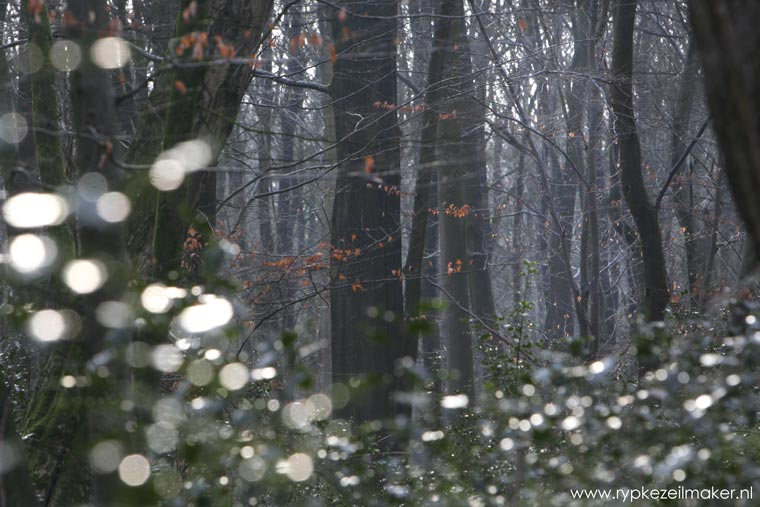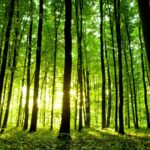Van de Technische Universitat Munchen ontving ik het volgende goede nieuws (is bij ons wél nieuws), na een studie in Nature van enkele van hun wetenschappers. Ik interviewde ooit ecoloog Josef Reichholf van die universiteit en dan word je daarna target van de PR-afdeling. De studie vermeldt een 77 procent snellere groei van beuken en 32 procent snellere groei van naaldbomen vergeleken met 1960: dankzij meer CO2 in de atmosfeer, meer stikstofbemesting. Die stikstof zou in de jaren ’80 waldsterben’ veroorzaken ‘door de ‘zure regen’maar wat de bomen betreft was het eigenlijk Zure Zegen.Ook het langere groeiseizoen door gestegen temperaturen helpt de bosgroei. Klimaatveraangenaming noemen wij dat hier, met name om ge-emotioneerde Groen Links-types op de kast te krijgen die nu vol dedain hun gezicht afwenden: zodat ze de feiten niet hoeven zien die hun ideologie weerspreken.
Global change: Trees continue to grow at a faster rate
Study highlights forest growth trends from 1870 to the present
Trees have been growing significantly faster since the 1960s. The typical development phases of trees and stands have barely changed, but they have accelerated – by as much as 70 percent. This was the outcome of a study carried out by scientists from Technische Universität München (TUM) based on long-term data from experimental forest plots that have been continuously observed since 1870. Their findings were published recently in Nature Communications.
Three decades ago, “forest dieback” was a hot topic, with the very survival of large forest ecosystems seemingly in doubt. But instead of a collapse, the latest studies indicate that forests have actually been growing at a faster rate. Whether, how and why forest stands have changed their growth patterns over the last century are still hotly disputed questions.
This latest study provides some answers. It was based on data from experimental forest plots that have been observed systematically since 1870. This makes them among the oldest forest study sites in the world. The forested areas are also representative of the typical climate and environmental conditions found in Central Europe. “Our findings are based on a unique data pool,” maintains Prof. Hans Pretzsch from TUM’s Chair for Forest Growth and Yield, who headed up the study.
Accelerated growth
In the cases of spruce and beech, respectively the dominant species of coniferous and deciduous trees in Central Europe, the TUM scientists noted significantly accelerated tree growth. Beech trees exhibited a growth rate that was 77 percent faster than in 1960, while the figure for spruce was 32 percent faster. The stand volume growth for beech was 30 percent, and 10 percent for spruce. “The stands as a whole had a lower growth rate than the individual trees essentially because larger trees require more space, hence each stand will have fewer trees,” explains Pretzsch.
The scientists are putting the growth acceleration down to rising temperatures and the extended growing season. Carbon dioxide (CO2) and nitrogen are other factors contributing to the faster growth. The concentrations of these gases in the atmosphere have been rising steadily over the last century. “Interestingly, we observed that acid rain only had a temporary slowing effect on the growth of our experimental plots. Indeed, the input of pollutants started to fall off significantly from the 1970s,” says Pretzsch. “It is true though that only a few of our experimental areas are located in the ridges of the highland mountains where the greatest damage was observed.”
Change requires adaptation
While the trees both grow and age faster, the appearance of the forest does not change as a result. But the same tree and stand sizes are achieved significantly earlier than in the past. This could benefit the forestry industry in that target diameters and the optimal harvest rotation age will be reached sooner. Besides, more wood can be harvested without compromising the principle of sustainability.
At the same time, the altered timescale has not yet been incorporated into traditional forestry yield models, which monitor growth merely as a function of age. The risk here is that the newly discovered benefits will not be exploited. Meanwhile, the accelerated growth and ageing of trees is also significant for the forest ecosystem as a whole, as Pretzsch explains: “The plant and animal species that will be most affected are those living in habitats which depend on special phases and structures of forest development. These species may have to become more mobile to survive.”
Long-term observation provides unique pool of data
The study was based on 600,000 individual tree surveys conducted since 1870. Over such a long timescale, it was possible to determine from the growth of the trees how they responded to changing environmental conditions. Pretzsch adds: “Even though the experimental areas varied in terms of climate and soil conditions, we were still able to discern an overall trend of faster growth.”
But it is not just the experimental plots and the long observation period that make the data so interesting. “We did not observe the trees in isolation, but rather always in interaction with their neighbors. This helped us understand how the dynamics of individual trees influence the stand as a whole. The growth trends at stand level are relevant for the forestry industry in terms of productivity, carbon sequestration and climate risks,” concludes Pretzsch.
Publication:
Forest stand growth dynamics in Central Europe have accelerated since 1870,
Pretzsch, H., Biber, P., Schütze, G., Uhl, E., Rötzer, Th., (2014)
Nat. Commun. 5:4967, DOI:10.1038/ncomms5967







Zo blijkt maar weer dat we beter af zijn met een beetje opwarming dan afkoeling.
Alhoewel de AGW discussie wel wat afkoeling en nuchterheid kan gebruiken.
Hoe was het ook weer met de citroenzuurcyclus… je stopt er CO2, water en zonlicht in en er komen carbohydraten en O2 uit. Dus als een stijgend CO2-gehalte tot gevolg heeft dat er meer CO2 wordt vastgelegd in biomassa dan zou je mogen verwachten dat het CO2-gehalte in de atmosfeer uiteindelijk stabiliseert of zelfs lager wordt. Dat klinkt mij in de oren als een perfect zelfregulerend systeem. En dat doet het al zo’n 500 miljoen jaar, een aanwijzing dat het een succesformule is.
Je beschrijft ‘fotosynthese’ Chris, de citroenzuur of Krebscyclus is het tegenovergestelde: het breekt suikers (en vetten en eiwitten) af om er energie en bouwstenen uit te halen.
Maar het artikel onderbouwt het ‘zelfregulerend effect’ dat biomassa meer CO2 vastlegt bij toename van CO2 in de atmosfeer.
Ofwel beter groeit, net als voedselplanten!
Klimaatveraangenaming: prima voor de woordenlijst!
Maar voor het hier beschreven verschijnsel past toch de uitdrukking van de Idso’s beter: CO2 verrijking!
Dit was naar aanleiding van de eerste CO2-boomexperimenten.
http://climategate.nl/2014/07/19/iccc9-science/
Ze kwamen al jaren geleden uit op deze spectaculaire groeicijfers door CO2 verrijking. Gaven per plant de groeipercentages en de toename van gewicht van geproduceerde vruchten, zelfs de toename van de vitamines in de vruchten.
Goh, jullie geloofden toch niet in klimaatverandering. Ik kan me nog diverse artikelen herinneren, weliswaar al enige tijd terug gepubliceerd , waarin de opwarming als een linkse hobby weg weggezet.
“Geert de Intellectueel Integriteitloze Blogtroll”
hahahahahahhahahahha. Wat een lol. Naampjes veranderen omdat de inhoud niet aanstaat.
En dat noemt zich wetenschapper.
Hoewel planten sneller groeien met meer co2 (geen nieuws) betekent dit niet dat de toename van co2 in de atmosfeer ‘dus’ geremd zal worden en geen aandachtspunt meer is. Immers, co2 wordt welliswaar tijdelijk vastgelegd door planten, maar slechts tot ze sterven en verrotten. De co2 opname capaciteit van planten is namelijk vooral een functie van het landoppervlak dat ze bezetten, en niet de snelheid van hun groei.
Bovendien is niet de co2 concentratie de limiterende factor voor de meeste planten, maar de beschikbaarheid van water en bodemnutrienten. Een toename van de co2 concentratie in combinatie met langere of regelmatigere periodes van droogte leidt netto tot afname van plantengroei. Al met al verwachten wetenschappers daarom (Zie de laatste IPCC beoordeling van de stand van de klimaatwetenschap) dat de (bekende en bescheiden) korte-termijn voordelen van de toename van co2 voor plantengroei (in bepaalde regio’s) in de loop van deze eeuw al zullen worden overtroffen door de negatieve effecten van voortdurende temperatuurstijging en verandering van neerslagpatronen.
Wanneer CO2 niet de limiterende factor is, kan een toename in atmosferische CO2 per definitie geen versnelling in groei veroorzaken.
Ik zet vraagtekens bij je bewering Chemical, dat je geen groeiversnelling zou kunnen krijgen door verhoogd CO2 als dat niet de limiterende factor is omdat het watergebruik van de plant efficiënter wordt bij een hoger CO2 gehalte.
Wanneer waterschaarste de limiterende factor is in de natuur, aan de rand van de woestijn bijvoorbeeld, dan helpt extra CO2 de plant wel degelijk overleven en groeien.
Vandaar de vergroening aan de randen van de woestijnen.
Wat is de reden van de toegenomen efficientie in watergebruik? Komt dat doordat bij hogere CO2 meer CO2 fixatie plaatsvindt ( en daardoor ook meer H2O wordt vastgelegd)?
We hebben gezien Joris, wat de projecties van het IPCC waard zijn, namelijk niets, vooral die in de “Summary for Policymakers”. Een warmere wereld is op termijn vooral ook een nattere wereld, zoals de opvolging van ijstijden en interglacialen laat zien. Het holoceen thermisch maximum had heel weinig woestijngebied op de wereld en naar een dergelijke situatie gaan we hopelijk weer toe.
Dat planten sneller groeien bij hogere CO2 is voor ons inderdaad geen nieuws, wel voor het IPCC. In hun rapporten kan ik nergens vinden dat dankzij de toegenomen CO2 concentratie de plantengroei in de afgelopen decennia is toegenomen. Het feit dat het IPCC positieve effecten van CO2 bagatelliseert of ontkent is natuurlijk ook geen nieuws, want doom and gloom zijn de pijlers van hun business model.
http://ipcc-wg2.gov/AR5/images/uploads/WGIIAR5-Chap4_FGDall.pdf
(Zoek op “fertilization” om te zien dat Chemical liegt.)
@Joris, dank voor die geinformeerd klinkende bewering die waar kan zijn op sommige locaties voor zover het de invloed van neerslag en nutrienten betreft, maar ik zag deze studie uit Nature Geoscience voorbijkomen dat het ‘droger wordt droger natter wordt natter verhaal’weerlegt waar het IPCC en onze nationale overheid steeds op varen
Nieuw onderzoek gepubliceerd in Nature Geoscience deze week:.
Citaat:
“We vinden dat voor meer dan driekwart van de wereldwijde landgebieden geen robuuste veranderingen in verdroging kunnen worden geconstateerd. Slecht 10.8% van het land laat een robuust patroon zien van ‘droog wordt droger, nat wordt natter’. Daar staat tegenover dat voor 9.5% van het land precies het tegenovergestelde gebeurt. We concluderen dan ook dat veranderingen in droogte boven land, welke de potentieel de groote sociaal-economische gevolgen kunnen hebben, niet het simpele patroon van versterking van bestaande patronen volgt.”
Einde citaat.
Greve P, Orlowsky B, Müller B, Sheffield J, Reichstein M, Seneviratne SI. Global assessment of trends in wetting and drying over land. Nature Geoscience, 14th September 2014. DOI: 10.1038/ngeo2247 http://dx.doi.org/10.1038/ngeo2247
Dit artikel gaat over het verleden en is beperkt relevant. De hamvraag is wat er gaat gebeuren als de temperatuur op aarde met 3 graden C stijgt.
Dat planten beter groeien bij een hogere CO2-concentratie verbaasd mij niets. In de cel- en weefselkweek wordt standaard gewerkt met een CO2-percentage van 5%, omdat cellen dan beter groeien. Toch wel even iets anders dan onze atmosferische 0,04%.
Kennelijk hebben de cellen nog in hun herinnering dat vroeger (in verre prehistorische tijden) het CO2-gehalte van de atmosfeer vele malen hoger was dan nu, en leven ze nu in een tijd van CO2-schaartste.
@Joris. Gezien dit feit ben ik het daarom ook niet helemaal met je eens dat alleen water en nutriënten de limiterende factor zijn voor groei. CO2 is, naar mijn idee, wel degelijk ook een limiterende factor.
@Chemical. Ik heb ergens gelezen dat bij hogere CO2-concentraties planten minder huidmondjes aanmaken in hun bladeren, waardoor er minder verdamping plaats vindt er er dus zuiniger met water wordt omgegaan!
Ik zet een vraagteken bij je verklaring dat cellen bij 5% CO2 beter zouden groeien vanwege hun “herinnering” aan prehistorische tijden. In celkweek staat 5% CO2 boven de (dierlijke) cellen om er voor te zorgen dat de pH van het kweekmedium in de fysiologische pH range blijft.
Hier een uitleg over het stomata (huidmondjes) verhaal
http://evolution.berkeley.edu/evolibrary/article/mcelwain_03
Ik neem aan dat het beter groeien vastleggen van CO2 niet alleen voor landplanten geldt. Co2 in water is in evenwicht met dat in de lucht. Ook groene algen en wier zullen harder groeien volgens onze hypothese. Er moeten dus miljoenen tonnen extra voedsel groeien voor vis. Mogelijk ontstaat uit uitzakkende biomassa in de zee, bedekt door ander bezinksel, de extra aardolie die over 50 miljoen jaren gewonnen zal worden. voor de kust van Californië zijn grote onderzeese bossen van wier, daar zou men ook wel eens aan kunnen meten. De zee wordt normaal als slachtoffer van de extra CO2 voorgesteld, wat betreft bepaalde koralen door “zuurder”water (minder basisch). Maar heeft men al wat geconstateerd en gemeten betreffende dit te verwachten fenomeen?